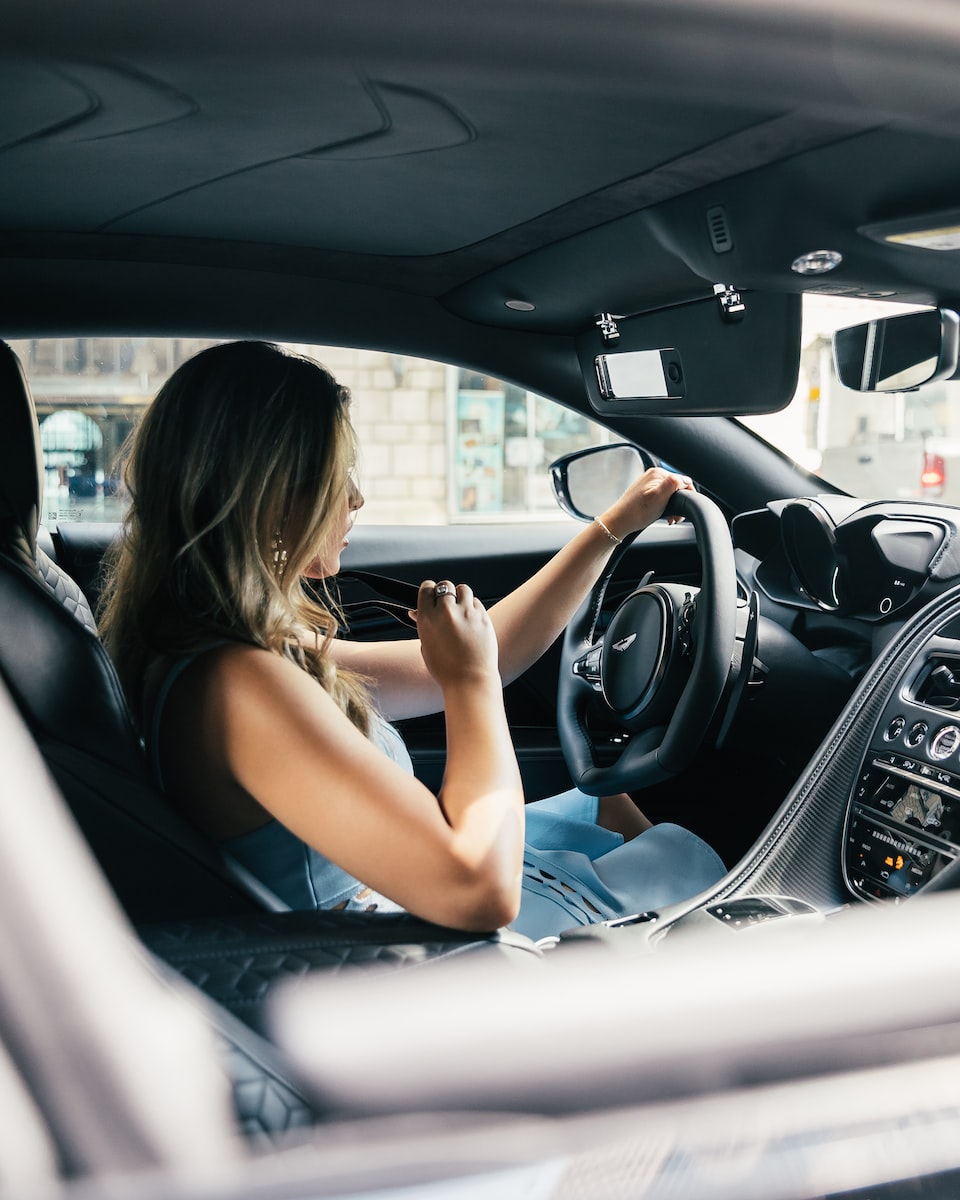Driving in heavy traffic can be an intimidating experience for some people, but with these tips on how to drive a car safely in traffic, you can stay confident and in control on the road. The constant flow of cars, motorcycles, and trucks can make it challenging to maintain focus, but by following some basic guidelines and tricks, you can navigate through traffic with ease and peace of mind. Whether you’re a seasoned driver or a beginner, this guide provides the knowledge and tools you need to drive safely and responsibly in any traffic situation.
- Keep a safe following distance
- Use your signals
- Stay focused
- Anticipate other drivers’ actions
- Check your blind spots
- Take breaks
- Follow the speed limit
- Avoid aggressive driving
Keep a safe following distance
Make sure to keep a safe following distance between your vehicle and the one in front of you. This allows you to react quickly in case of sudden stops or changes in speed. A good rule of thumb is to keep at least two car lengths between you and the vehicle in front of you.
Keeping a safe following distance while driving is an important aspect of safe driving. It refers to the distance between your vehicle and the one in front of you. A safe following distance allows you to react quickly to sudden stops or changes in speed and reduces the risk of a rear-end collision.
A general rule of thumb is to maintain a following distance of at least two car lengths between you and the vehicle in front of you. This provides enough space to react to unexpected situations, such as a sudden stop, and reduces the risk of an accident. However, the appropriate following distance can vary based on factors such as road conditions, speed, and visibility.
In poor weather conditions, such as rain or snow, it’s important to increase your following distance to allow for longer stopping times and improved visibility. Additionally, when driving on highways or in fast-moving traffic, it’s important to maintain a greater following distance to account for higher speeds.
Remember, a safe following distance is a critical aspect of defensive driving, and it’s important to keep a close eye on the vehicle in front of you and adjust your speed and distance accordingly. By doing so, you’ll be able to drive safely and confidently on the road, regardless of traffic conditions.
Use your signals
Always use your signals when changing lanes, merging, or turning. This allows other drivers to anticipate your actions and gives them time to react.
Traffic signals are crucial tools that help regulate the flow of traffic and keep drivers, cyclists, and pedestrians safe on the road. However, not everyone knows how to use them correctly, which can lead to confusion and dangerous situations. In this article, we’ll cover some tips on how to properly use traffic signals while driving.
Pay attention to the colors – Red lights mean stop, yellow lights mean caution, and green lights mean go. Be sure to follow these basic rules, and never try to beat a red light.
Stop at the marked line – When approaching a red light, make sure to stop at the marked line, or just before it if there’s no line. This gives other drivers and pedestrians a clear view of your vehicle.
Keep your distance from the vehicle in front of you – When stopped at a red light, keep a safe following distance from the vehicle in front of you. This allows you to react quickly in case the light turns green and the vehicle in front of you doesn’t move.
Observe the pedestrian crosswalks – When the signal changes to green, be sure to check for pedestrians in crosswalks before proceeding. Always give way to pedestrians, and be cautious of those who may be crossing outside of crosswalks.
Yield to other vehicles – When making a right turn on a red light, always yield to other vehicles and pedestrians. Only proceed if it’s safe to do so.
Follow the right-of-way rules – Always follow the right-of-way rules, which determine who has the right to go first at intersections. Usually, the vehicle on the right has the right-of-way, but there are exceptions, such as when a sign or signal directs otherwise.
Avoid blocking intersections – When stopped at a red light, avoid blocking the intersection. This can cause confusion and delays for other drivers.
By following these tips and using traffic signals correctly, you can help keep yourself and others safe on the road. Remember, traffic signals are designed to regulate the flow of traffic and prevent accidents, so be sure to pay attention to them and follow their directions. With these guidelines in mind, you can enjoy a safer and more efficient driving experience.
Stay focused
Staying focused while driving is crucial for ensuring safety on the road. Distracted driving is a major contributor to accidents, and it increases the risk of a collision. To maintain focus, it’s essential to follow these tips:
- Avoid distractions – To minimize the risk of an accident, it’s important to avoid activities that take your attention away from the road, such as using your phone, eating, or putting on makeup. These distractions can significantly reduce your reaction time.
- Keep your eyes on the road – Maintaining a focused gaze on the road ahead and regularly scanning the area for potential hazards is crucial in helping you quickly respond to any unexpected situations.
- Limit conversation – Distracting conversation with passengers, particularly emotionally charged or complex discussions, can take your attention away from the road. Instead, wait until you’ve safely parked to engage in important conversations.
- Get adequate rest – Fatigue can significantly impact your focus and reaction time. Ensure that you get enough rest and take breaks if you start to feel drowsy while driving.
- Reduce stress – Stress can also negatively impact your focus while driving. To keep yourself relaxed and focused, try deep breathing, listening to calming music, or other stress-management techniques.
By staying focused while driving, you can reduce the risk of a collision and arrive safely at your destination. Avoiding distractions, keeping your eyes on the road, and taking steps to reduce stress can help you quickly react to any unexpected situations, ensuring your safety and the safety of others on the road.
Anticipate other drivers’ actions
Anticipating other drivers’ actions is an important aspect of safe driving. By anticipating the actions of other drivers, you can respond quickly to potential hazards and reduce the risk of a collision. Here are some tips to help you anticipate other drivers’ actions:
- Observe other drivers – Keep an eye on other drivers around you and pay attention to their body language, eye movements, and the position of their vehicle. This can give you a good indication of their intended actions.
- Watch for signals – Look for signals, such as turn signals or brake lights, that indicate what other drivers are planning to do. This can help you to anticipate changes in speed or direction.
- Consider road conditions – Consider the road conditions, such as traffic, road signs, and weather, when anticipating other drivers’ actions. These conditions can impact drivers’ decisions and actions.
- Stay alert – Stay alert and focused while driving, and be ready to react quickly to any changes in the driving environment.
- Assume the worst – Assume that other drivers may not always make the safest or most predictable decisions. This can help you to be prepared for unexpected situations.
By anticipating other drivers’ actions, you can increase your situational awareness and reduce the risk of a collision. Additionally, by being proactive and prepared for potential hazards, you’ll be able to make safer decisions on the road, helping to keep yourself and others safe.
Check your blind spots
Checking your blind spots is an important aspect of safe driving. Blind spots are areas around your vehicle that you can’t see through your mirrors or through a direct line of sight. To check your blind spots, it’s important to follow these tips:
- Use your mirrors – Use your side and rearview mirrors to check for vehicles or other objects in your blind spots. Make sure to adjust your mirrors correctly to maximize your visibility.
- Turn your head – Regularly turn your head to check for vehicles or other objects that may be in your blind spots. This helps to confirm what you see in your mirrors and provides a more comprehensive view of your surroundings.
- Check before changing lanes – Before changing lanes, check your blind spots to make sure it’s safe to do so. Look over your shoulder to get a better view of the area behind you.
- Be aware of larger vehicles – Larger vehicles, such as trucks or buses, have larger blind spots, so it’s important to be especially cautious when driving near them.
- Use technology – Some vehicles come equipped with blind spot monitoring systems, which use sensors to alert you when there’s a vehicle or object in your blind spot. If your vehicle has this feature, make sure to use it.
By checking your blind spots regularly, you can reduce the risk of a collision and ensure that you drive safely on the road. Additionally, by being aware of your surroundings and paying attention to potential hazards, you’ll be able to make safer decisions while driving.
Take breaks
Taking breaks is an important aspect of safe driving. Driving for long periods of time can lead to fatigue, which can impair your judgment and reaction times and increase the risk of a collision. To take breaks safely, it’s important to:
Plan ahead – Plan your route in advance and consider taking breaks every two hours or 100 miles, whichever comes first.
Find a safe place to stop – Look for a safe place to stop, such as a rest area or a parking lot, to take a break. Avoid stopping on the side of the road if possible.
Get out of the car – Get out of the car and stretch your legs, do some light exercise, or take a walk. This will help you feel refreshed and energized.
Drink water – Stay hydrated by drinking water and avoiding caffeinated or sugary drinks.
Take a nap – If you’re feeling tired, consider taking a nap for 20-30 minutes to help refresh your mind and improve your alertness.
Avoid distractions – While taking a break, avoid using your phone or engaging in other activities that may distract you from the road.
By taking regular breaks, you can help reduce the risk of fatigue and ensure that you stay focused and alert while driving. Additionally, by being mindful of your own well-being and taking the time to rest and recharge, you’ll be able to drive safely and effectively.
Follow the speed limit
Following the speed limit is an important aspect of safe driving. Speed limits are set by state and local authorities and are designed to help ensure the safety of everyone on the road. To follow the speed limit safely, it’s important to:
- Know the speed limit – Familiarize yourself with the speed limits in the areas you’re driving in and make sure to obey them at all times.
- Adjust your speed for conditions – The posted speed limit may not always be appropriate for the driving conditions, such as heavy traffic, inclement weather, or road construction. In these cases, adjust your speed accordingly.
- Be mindful of other road users – Be mindful of other road users, including pedestrians, cyclists, and other vehicles, and adjust your speed to ensure their safety.
- Avoid aggressive driving – Avoid aggressive driving behaviors, such as tailgating, cutting off other vehicles, and speeding. These behaviors can increase the risk of a collision and put yourself and others in danger.
- Use cruise control carefully – If your vehicle is equipped with cruise control, use it carefully and make sure to adjust your speed manually when necessary.
By following the speed limit and adjusting your speed for conditions, you can help reduce the risk of a collision and ensure the safety of everyone on the road. Additionally, by being mindful of other road users and avoiding aggressive driving behaviors, you’ll be able to drive safely and responsibly.
Avoid aggressive driving
Avoiding aggressive driving is an important aspect of safe driving. Aggressive driving refers to behaviors that are dangerous and increase the risk of a collision. To avoid aggressive driving, it’s important to:
- Keep your emotions in check – Avoid getting angry or upset while driving, and don’t let your emotions get the best of you. Instead, take deep breaths and try to stay calm.
- Don’t tailgate – Tailgating, or following too closely behind another vehicle, can be dangerous and increase the risk of a rear-end collision. Keep a safe following distance and give other vehicles plenty of space.
- Don’t cut off other vehicles – Cutting off other vehicles is a dangerous behavior that can cause a collision. Always use your turn signals and check your blind spots before changing lanes.
- Don’t speed – Speeding increases the risk of a collision and makes it more difficult to react to sudden changes in traffic or road conditions. Follow the speed limit and adjust your speed for conditions.
- Avoid road rage – Road rage is a type of aggressive driving that involves violent or dangerous behavior. If you’re a victim of road rage, try to avoid engaging with the aggressive driver and call the police if necessary.
By avoiding aggressive driving behaviors, you can help reduce the risk of a collision and ensure the safety of everyone on the road. Additionally, by being mindful of your own behavior and avoiding dangerous actions, you’ll be able to drive safely and responsibly.
Conclusion
In conclusion, driving in traffic can be challenging, but by following the tips and guidelines outlined in this article, you can confidently and safely navigate through any traffic situation. From staying focused and avoiding distractions, to anticipating other drivers’ actions and following the right-of-way rules, these simple steps can help reduce the risk of a collision and ensure a smooth and safe driving experience. Additionally, taking breaks and following the speed limit can help you stay alert and focused on the road, while avoiding aggressive driving can prevent road rage and keep you and others safe. By being proactive and taking these precautions, you can enjoy the freedom of driving while also staying safe and secure on the road.
Share this on .....



